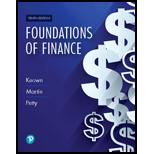
Pearson eText Foundations of Finance -- Instant Access (Pearson+)
10th Edition
ISBN: 9780135639382
Author: Arthur Keown, John Martin
Publisher: PEARSON+
expand_more
expand_more
format_list_bulleted
Concept explainers
Question
Chapter 6, Problem 16SP
a.
Summary Introduction
To determine: The holding period return for each month.
b.
Summary Introduction
To determine: The average monthly returns and standard deviation for Company C and S&P I.
c.
Summary Introduction
To determine: Graphing the returns of Company C and S&P I.
d.
Summary Introduction
To determine: The nature of relationship between Company C’s stock and S&P I.
Expert Solution & Answer
Want to see the full answer?
Check out a sample textbook solution
Students have asked these similar questions
Finance prob.
Need abs
Need answer n
Chapter 6 Solutions
Pearson eText Foundations of Finance -- Instant Access (Pearson+)
Ch. 6 - a. What is meant by the investors required rate of...Ch. 6 - Prob. 2RQCh. 6 - What is a beta? How is it used to calculate r, the...Ch. 6 - Prob. 4RQCh. 6 - Prob. 5RQCh. 6 - Prob. 6RQCh. 6 - Prob. 7RQCh. 6 - What effect will diversifying your portfolio have...Ch. 6 - (Expected return and risk) Universal Corporation...Ch. 6 - (Average expected return and risk) Given the...
Ch. 6 - (Expected rate of return and risk) Carter, Inc. is...Ch. 6 - (Expected rate of return and risk) Summerville,...Ch. 6 - Prob. 5SPCh. 6 - Prob. 9SPCh. 6 - Prob. 10SPCh. 6 - Prob. 11SPCh. 6 - Prob. 12SPCh. 6 - Prob. 14SPCh. 6 - (Capital asset pricing model) Using the CAPM,...Ch. 6 - Prob. 16SPCh. 6 - Prob. 17SPCh. 6 - a. Compute an appropriate rate of return for Intel...Ch. 6 - (Estimating beta) From the graph in the right...Ch. 6 - Prob. 20SPCh. 6 - Prob. 21SPCh. 6 - (Capital asset pricing model) The expected return...Ch. 6 - (Portfolio beta and security market line) You own...Ch. 6 - (Portfolio beta) Assume you have the following...Ch. 6 - Prob. 1MCCh. 6 - Prob. 2MCCh. 6 - Prob. 3MCCh. 6 - Prob. 4MCCh. 6 - Prob. 5MCCh. 6 - Prob. 6MCCh. 6 - Prob. 7MCCh. 6 - Prob. 8MCCh. 6 - Prob. 9MCCh. 6 - Prob. 10MCCh. 6 - Prob. 11MC
Knowledge Booster
Learn more about
Need a deep-dive on the concept behind this application? Look no further. Learn more about this topic, finance and related others by exploring similar questions and additional content below.Similar questions
- solve this problem qn ??arrow_forwardWhich of the following is not an investment grade credit rating?* BB+ BBB+ BBB BBB-arrow_forwardCompany A has a capital structure of $80M debt and $20M equity. This year, the company reported a net income of $17M. What is Company A's return on equity?* 117.6% 21.3% 85.0% 28.3%arrow_forward
- 12. Which of the following is the formula to calculate cost of capital?* Total assets/Net debt x Cost of debt + Total assets/Equity x Cost of equity Net debt/Equity x Cost of debt + Equity/Net debt x Cost of equity Net debt x Cost of debt + Equity x Cost of equity Net debt/Total assets x Cost of debt + Equity/Total assets x Cost of equity .arrow_forwardno ai .What is the enterprise value of a business?* The market value of equity of the business The book value of equity of the business The entire value of the business without giving consideration to its capital structure The entire value of the business considering its capital structurearrow_forward10. The concept of time value of money is that* The cash flows that occur earlier are more valuable than cash flows that occur later The cash flows that occur earlier are less valuable than cash flows that occur later The longer the time cash flows are invested, the more valuable they are in the future The future value of cash flows are always higher than the present value of the cash flows .arrow_forward
arrow_back_ios
SEE MORE QUESTIONS
arrow_forward_ios
Recommended textbooks for you
